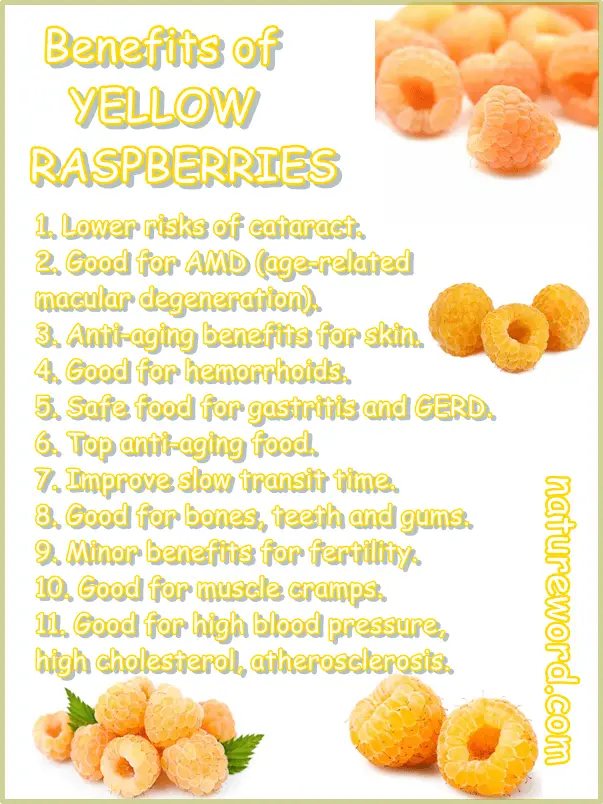Yellow raspberries are in season right now and a healthy summer fruit to add to your diet. Bright and colorful, they are a spectacular presence and good for health at the same time.
Studies show biologically active antioxidant constituents in yellow raspberries lower risks of cataract and age-related blindness.
Yellow raspberries have mild antihypertensive benefits and are a top antiaging food.
1- Lower risks of cataract
Did you know yellow raspberries lower risks of cataract? Lutein and zeaxanthin, the pigmented xanthophyll antioxidants that give yellow raspberries their color, have been shown to lower risks of cataract when present in sufficient amounts in the diet. Risks of cataract for those with a high intake of the two yellow antioxidants are up to 32% lower, studies show (source).

According to research, lutein and zeaxanthin represent more than 80% of the total carotenoids physically present in the human retina (source).
This fact alone highlights the importance of eating yellow foods such as yellow raspberries, but also yellow carrots and yellow bell peppers, yellow fleshed sweet potatoes, yellow watermelon and yellow tomatoes for good vision and eye health.
2- Benefits for age-related macular degeneration (AMD) causing loss of vision
In addition to measurably lowering risks of cataract, the pigmented yellow antioxidants lutein and zeaxanthin in yellow raspberries get absorbed into the retina and macula lutea area of the eye where they exert a photoprotective effect. More exactly, the antioxidants protect eyes against damage from sunlight radiation which causes structural changes leading to irreversible loss of vision or blindness in the form of AMD, age-related macular degeneration.
Studies have identified lutein and zeaxanthin, one of the main biologically active compounds in yellow raspberries, as having ‘the capacity to modulate defense and repair systems that operate in response to oxidative stress and inflammation’. This translates into a reduction of risk factors for age-related loss of vision, positively altering the pathogenesis and progression of the disease (source).

3- Antiaging benefits for skin
Yellow raspberries have a good content of vitamin C. How much vitamin C in yellow raspberries? A serving of 100 grams of the fresh fruit provides around 30% of daily vitamin C values for the average adult.
Vitamin C is directly involved in collagen production, stimulating the synthesis of collagen in the skin for better skin elasticity and fewer wrinkles.
Moreover, vitamin C has scientifically recognized antioxidant properties. What this means is that it scavenges harmful free radical molecules and counteracts and repairs structural damage produced by them in the form of oxidative stress for a more youthful appearance.
Yellow raspberries are also a good source of vitamin E with 5.8% of daily recommended intakes in every 100 grams. While vitamin C is contained in the fresh fruit, vitamin E is contained in the tiny seeds.
Together, vitamins C and E exert skin photoprotective effects that cumulate with an antiaging action.
4- Good to eat for hemorrhoids
If you have hemorrhoids or piles, then yellow raspberries are a good food to eat for you. While they don’t hold benefits specifically for hemorrhoids, as in they cure hemorrhoids, which no food does, yellow raspberries help regulate the frequency of bowel movements and improve their consistency, helping achieve more regular bowel movements that are easy to pass. Regular consumption can help improve hemorrhoids symptoms and prevent flare ups.
img
5- Safe to eat in gastritis and acid reflux
Yellow raspberries are recognized as being the sweetest of all raspberry colors. What makes them taste sweeter than other colors is their lack of acidity.
This is also what recommends them for consumption in gastritis and GERD, or acid reflux disease. What makes yellow raspberries good to eat with gastritis and acid reflux is the fact that they makeup simply does not flare up the digestive conditions.
6- Antiaging food
Yellow raspberries qualify as an anti-aging food. For one, the raspberry variety is a good source of vitamin C which stimulates the production of collagen. Collagen is a structural protein responsible for maintaining structure in tissues throughout the body, from skin to bones and teeth.
Collagen contributes to skin elasticity and, when produced in sufficient amounts, exerts an antiaging action on the skin, helping delay wrinkles and attenuate fine lines.
It’s also needed in tendons and cartilage where it ensures structure and resilience and supports mobility for the maintenance of an active lifestyle with age.
Yellow raspberries are also a natural source of ellagitannins, highly bioactive components that get metabolized by gut bacteria and turned into an anti-aging constituent called Urolithin A. Urolithin A activates mitophagy, inducing a molecular signature that improves mitochondrial and cellular health in humans, according to research.
Animal studies also show Urolithin A prevents the accumulation of dysfunctional mitochondria, normal with age, extending lifespan in the nematode C. elegans, and in rodents, it improved age-related decline in muscle function and exercise capacity. Researchers believe the findings can be extrapolated to humans.
7- Improve slow transit time
Eating yellow raspberries regularly helps improve transit time with benefits for constipation. Full of tiny seeds, yellow raspberries have a high content of dietary fiber with laxative effects. Dietary fiber in the fruit helps stimulate contractions of the muscles of the intestinal tube that move food along the digestive tract.
How much dietary fiber in yellow raspberries? A serving of 100 grams of the fresh fruit has 6.5 grams of dietary fiber.
8- Good for bones, teeth and gums
Eating yellow raspberries helps keep teeth and gums healthy and it’s for the most surprising reason. Vitamin C in yellow raspberries stimulates the production of collagen types 1 and 3, resulting in functional benefits related to the development and maintenance of bone tissue, actively contributing to strong, healthy teeth and bones.
Moreover, research shows vitamin C is directly involved in ‘regulating gene transcription in bone’ related to the the maturation and normal function of osteoblasts (study).
Osteoblasts are cells from which new bone grows. A deficiency of vitamin C, which is common and easily attainable, can negatively impact new bone formation at cell level and increase risks of frail bones and teeth and associated complications.
Vitamin C in yellow raspberries also help strengthen the walls of capillaries, tiny blood vessels in gums. In addition to preventing bleeding gums, vitamin C helps gums adhere well to teeth, as well as exerts antibacterial benefits, helping reduce risks of gum disease and associated side effects such as tooth loss.
9- Minor benefits for fertility in men and women
Eating yellow raspberries helps boost both female and male fertility. The good amounts of vitamin C in the fresh fruit support the production of progesterone, one of the two principal female hormones required for conception. Research suggests the nutrient is involved in the development of the corpus luteum, a structure that secretes progesterone and makes it possible for the pregnancy to develop.
Moreover, vitamin C accumulates in both female and male reproductive organs, protecting against free radical damage and associated DNA damage that may result in defects and chromosome abnormalities leading to pregnancy loss.
10- Minor benefits for muscle cramps
A serving of 200 grams of yellow raspberries provides around 10% of daily magnesium values for the average adult.
Upping magnesium intake helps with muscle contractions and painful muscle cramps such as eyelid twitching, cramps under the chin, foot cramps, leg cramps, including leg cramps at night and more.
11- Benefits for high blood pressure, high cholesterol and atherosclerosis
One of the biggest benefits of eating yellow raspberries is they help promote cardiovascular health. Magnesium and potassium in the fruit lower blood pressure numbers and heart rate.
In addition to being a good food to eat for high blood pressure and high heart rate, yellow raspberries are also beneficial for high cholesterol.
High in dietary fiber, the fruit affects changes in blood cholesterol profile, lowering levels of LDL cholesterol, also known as bad cholesterol.
Furthermore, vitamin K in yellow raspberries exerts anti-inflammatory and anti-atherosclerotic benefits, helping reduce risks of atherosclerosis and associated cardiovascular events.
Atherosclerosis causes plaque deposits to form on the inside of artery walls, leading to thickening and poor blood flow that predispose to cardiovascular events such as strokes.
The generous content of vitamin C in the fruit further helps keep the inside of blood vessels clear of plaque deposits and counteracts inflammation conducive to atherosclerosis.
